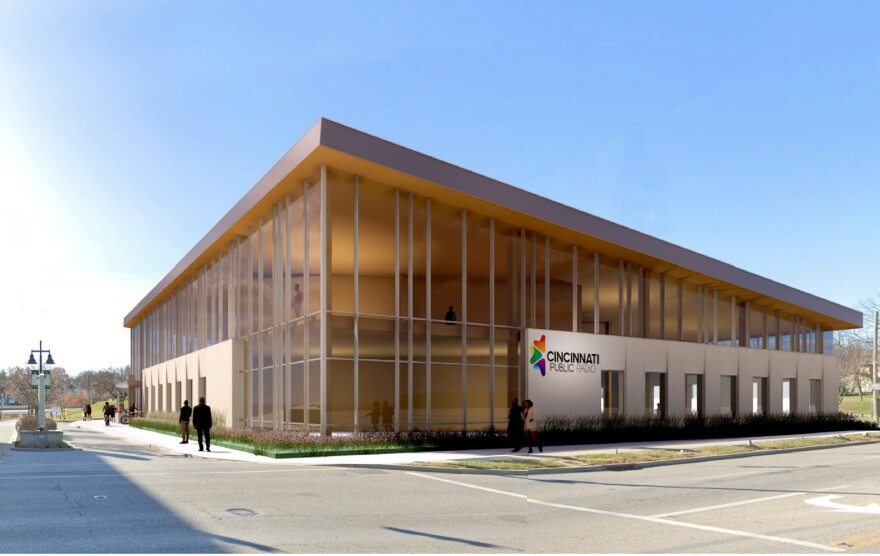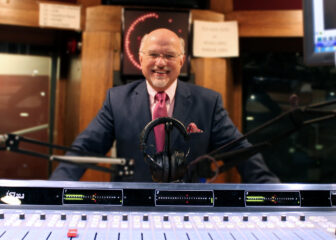Cincinnati Public Radio buys property for new headquarters

An artist's rendering of CPR's planned headquarters in Cincinnati's Evanston neighborhood.
Cincinnati Public Radio is moving full speed ahead with a capital campaign to finance construction of a new 30,000–square-foot headquarters.
The two-story building will include spaces for live performances and other events and a free, publicly accessible podcast studio. It will be part of Cincinnati’s first LEED-certified corporate campus, Keystone Parke, a tax-increment financing district created by the city in 2008.
CPR closed on the purchase of a land parcel in the district Tuesday. The Cincinnati City Council approved the developer’s request to remove the land from the TIF district last month, accommodating the public radio broadcaster’s nonprofit status.
Community Voices, a new donor circle created to build support for the project, has raised nearly half of the $26 million project cost during the silent phase of its capital campaign, according to GM Richard Eiswerth. On its website, the campaign makes the case for creating “a new type of public forum in our region and a new era of public radio” by supporting CPR’s new “community-fueled” headquarters. Campaign organizers expect to meet a deadline that will allow builders to break ground on construction by the end of the year, Eiswerth said.

CPR, a community-licensed public radio organization that includes classical WGUC and all-news WVXU, has outgrown its current office space on the second floor of the Crosley Telecommunications Center. CPR has rented the space from CET, Cincinnati’s PBS station, since around 1980, Eiswerth said. In addition to its cramped quarters for CPR staffers, the building offers limited public access, he said.
WGUC moved into the Crosley building 30 years ago, when it was an NPR news and classical music service owned by the University of Cincinnati. Over time, WGUC expanded and transformed into Cincinnati Public Radio through several waves of change. WGUC went independent from the university in 2002 and acquired WVXU from Xavier University three years later. With two signals, the stations streamlined their formats and rebranded as Cincinnati Public Radio.
CPR now operates a growing newsroom, and its stations transmit five program streams, including HD Radio channels devoted to jazz and Cincinnati-based independent music.
“With the acquisition of WVXU and the division of our streams of our main broadcast channel between full-time classical and full-time news, we obviously have greatly added to our staffing … and continue to add news people,” Eiswerth said. “We literally have people operating out of closets.”
CPR has been looking to relocate for several years. A desire to be “ensconced in an actual dynamic neighborhood,” as Eiswerth put it, was another consideration in planning its own headquarters. The Crosley Telecommunications Center is in a commercial district with dwindling residents, he said.
A 2018 proposal to construct a new building downtown, directly across the street from City Hall, fell through after an early cost projection for constructing on the site escalated significantly. CPR also wrestled with internal questions about whether a public radio news outlet should be located so close to the city government and its operations, Eiswerth said.
The Keystone Parke location didn’t cost as much and doesn’t require the remedial work of the downtown site, Eiswerth said.
Engaging with the public
The new headquarters will be within two miles of Xavier University, which maintains a close relationship with CPR, and the high schools where CPR offers student internships. The new location will offer free parking — another advantage for public accessibility.
The building design features a performance studio four times larger than CPR’s current studio, allowing WGUC to host music performances before in-person audiences. It also includes public space for hosting events.
When the building is completed, CPR will create three new full-time jobs, including a receptionist, a building maintenance staffer and an outreach coordinator/events producer. CPR expects to add more jobs later, according to Eiswerth.
“Because the new building will be twice the size of the space we occupy right now, we will have an opportunity to fill that space, we hope, over the next few years” and “to greatly expand our news department, which we have established as a major objective,” Eiswerth said.






